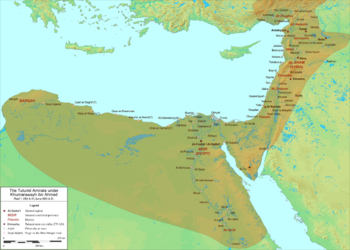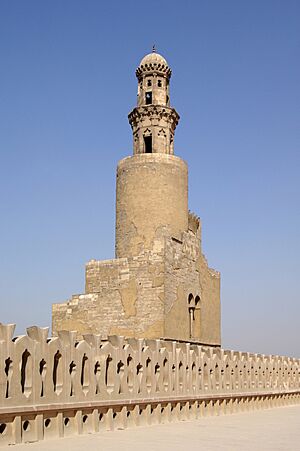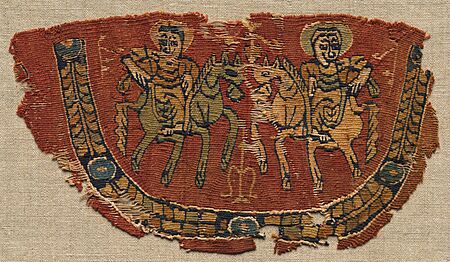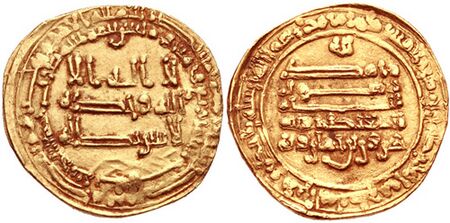Tulunids facts for kids
Quick facts for kids
Tulunid Emirate
الإِمَارَةُ الطُّولُونِيَّة (ar)
|
|||||||||||
|---|---|---|---|---|---|---|---|---|---|---|---|
| 868–905 | |||||||||||

Tulunid Emirate in 893.
|
|||||||||||
| Status | Vassal of the Abbasid Caliphate | ||||||||||
| Capital | Al-Qata'i | ||||||||||
| Common languages | Arabic, Egyptian, Greek, Syriac, Old Nubian (Public), Turkic (Army) | ||||||||||
| Religion | Sunni Islam (predominant), Orthodox Christians | ||||||||||
| Government |
|
||||||||||
| Emir | |||||||||||
|
• 868–884
|
Aḥmad ibn Ṭūlūn | ||||||||||
|
• 884–896
|
Khumarawayh ibn Ahmad ibn Tulun | ||||||||||
| History | |||||||||||
|
• Established
|
868 | ||||||||||
|
• Abbasid reconquest
|
905 | ||||||||||
| Currency | Dinar | ||||||||||
|
|||||||||||
The Tulunids were a powerful family of Turkic origin. They were the first independent rulers of Egypt and much of Syria. This was the first time Egypt had been ruled by its own leaders since the ancient Ptolemaic dynasty.
The Tulunids became independent in 868. They broke away from the main Abbasid Caliphate government. Their rule lasted until 905, when the Abbasids took back control of their lands.
In the late 800s, the Abbasid Caliphate faced many problems. It was hard for them to control faraway parts of their empire. In 868, a Turkic officer named Ahmad ibn Tulun became the independent governor of Egypt. He slowly gained more power, becoming almost fully separate from the Abbasid government.
During his rule (868–884) and his sons' rule, the Tulunid lands grew. They included areas like the Jordan Rift Valley, Hejaz, Cyprus, and Crete. Ahmad's son, Khumarawayh, took over after him. Khumarawayh was a strong leader in the Middle East. The Abbasids even recognized the Tulunids as rulers, but they were still seen as loyal to the Caliphate.
After Khumarawayh died, the next rulers were not as strong. Their Turkic and black slave-soldiers started to run the government. In 905, the Tulunids could not stop an invasion by Abbasid troops. The Abbasids then took back direct control of Syria and Egypt.
The Tulunid period brought many changes. There were improvements in the economy and government. There were also cultural changes. Ahmad ibn Tulun changed how taxes were collected. He also worked closely with merchants. He created the Tulunid army. The capital city moved from Fustat to al-Qata'i. This is where the famous Mosque of Ibn Tulun was built.
Contents
History of the Tulunids

The Tulunid dynasty rose and fell during a time when different regions in the Muslim world wanted more control. The Abbasid caliphate was having many problems. It was losing its power and control over its vast empire.
There had been other groups in Egypt and Baghdad who tried to gain power. But their success was only for a short time. There was also a power struggle between the Turkic army leaders and the government in Baghdad. On top of this, the empire was facing a money crisis. All these problems played a part in the Tulunid story.
The Abbasid caliphate itself was not stable. In 870, Abū Aḥmad al-Muwaffaḳ became the real ruler of the caliphate. Because of this uncertainty, Ahmad ibn Tulun could gain and expand his power. The Tulunids became a strong regional power. They were mostly free from the Caliph's direct orders. Other dynasties in the 800s, like the Aghlabids, also gained similar power.
Ahmad ibn Tulun's Rule
Ahmad ibn Tulun was part of a special Turkic guard. This guard was first in Baghdad. Later, it moved to Samarra, which became the new capital. In 868, Ibn Tulun was sent to Egypt to be its governor.
He quickly built up his power in Egypt. He created his own Egyptian army. He also took control of the money from Egypt and Syria. In 877, the Caliph sent troops against him. This was because Ibn Tulun was not sending enough tax money to Baghdad. But Ahmad ibn Tulun kept his power. The next year, he took control of Syria.
He ruled for more than ten years. He left behind a strong army, a good economy, and experienced officials. These officials helped run the government. He chose his son, Khumarawayh, to rule after him.
With full control, the tax money stayed in Egypt. This allowed for big projects like improving irrigation and building a navy. These projects helped the local economy and trade a lot. In 878, the Tulunids took over the Jordan Rift Valley. Their control reached as far north as the mountains near the Byzantine border. This helped them protect Egypt from Abbasid attacks.
Khumarawayh's Reign
After his father died, Khumarawayh became the ruler. His first challenge was an invasion of Syria. Armies sent by al-Muwaffak, the real ruler of the Abbasids, attacked. Khumarawayh also had to deal with one of his father's key allies, Ahmad ibn Muhammad al-Wasiti, who joined the invaders.
The young Tulunid leader won battles and gained political power. He expanded his control from Egypt into northern Iraq. His power reached as far north as Tarsus by 890. He became an important figure in the Middle East. He made two peace agreements with the Abbasids.
In the first agreement in 886, al-Muwaffak recognized Tulunid rule over Egypt and Syria for thirty years. The second agreement, made with al-Muʿtadid in 892, confirmed these terms. Both agreements also said that the Tulunid ruler was still loyal to the Caliph in Baghdad.
Despite his successes, Khumarawayh's rule also led to the dynasty's downfall. His lavish spending, political fights, and Abbasid efforts all contributed to the Tulunids' ruin. Khumarawayh relied completely on his Turkic and African soldiers. Under his rule, the money and army of the Syro-Egyptian state became unstable.
The End of the Tulunids
The later Tulunid rulers were not strong leaders. They relied on their Turkic and black soldiers to run the government.
Khumarawayh's son, Abu 'l-Asakir (also known as Jaysh), was removed from power by the Tulunid army in 896. This happened soon after he became ruler. His brother, Harun, took his place. Harun ruled for eight years, but he could not make the dynasty strong again. He was killed in 904. This happened when the Abbasid army had taken back Syria and was about to invade Egypt.
Harun's successor, his uncle Shayban ibn Ahmad ibn Tulun, could not stop the Abbasid invasion. The Abbasid army was led by Muhammad ibn Sulayman al-Katib. They also had naval support from forces led by Damian of Tarsus. This ended Shayban's rule and the Tulunid dynasty.
Tulunid Culture
Ahmad ibn Tulun built his own capital city called al-Qatā'i. It was just north of the old capital, Fustat. He set up his government there. One of the most important buildings in this city, which still stands today, is the Mosque of Ibn Tulun.
The mosque was built in a style common in Samarra. This was the style used when the Caliphate moved its capital from Baghdad to Samarra. This building style was used for both religious and everyday buildings. Some houses from the Tulunid period still have decorations in this Samarran style.
Khumarawayh spent even more money than his father. He built very fancy palaces and gardens for himself and his friends. People in Egypt at the time talked about his amazing blue-eyed palace lion. It showed how much he loved luxury. People also said his stables were so big that he never rode the same horse twice. Even though he spent a lot of the family's money, he also supported scholars and poets. He encouraged a rich cultural life.
Khumarawayh arranged a very important marriage in medieval Islamic history. He proposed that his daughter marry a member of the Caliph's family in Baghdad. His daughter, Ḳaṭr al-Nadā, married the Abbasid caliph al-Mu'tadid in 892. The wedding was incredibly expensive. Her dowry (money or gifts from the bride's family) was estimated to be between 400,000 and one million dinars. Some people think the Abbasids wanted the wedding to be so grand to make the Tulunids spend all their money.
The story of Ḳaṭr al-Nadā's splendid wedding was remembered by the Egyptian people for a long time. It was written about in history books and folk stories. This marriage was special because royal families rarely married each other in Islamic history. Also, in Islamic marriages, the custom is for the groom to give a mahr (bride price), not for the bride's family to give a dowry.
Ahmad ibn Tulun also supported Sunni scholars. This helped Islamic studies grow in Egypt. Especially the study of hadith (sayings and actions of Prophet Muhammad). This helped spread Islam in the countryside. Ibn Tulun officially supported the Shafi'i school of Islamic jurisprudence (Islamic law). This helped this school become popular again after it had declined.
Tulunid Military
During his rule, Ibn Tulun created his own Tulunid army and navy. He realized he needed his own armed forces after a revolt in Palestine in 870. So, Ibn Tulun built an army. It was made up of soldiers from Sudan and Greek slave-soldiers. Other reports say the soldiers were from Persia and Sudan.
Khumarawayh continued his father's plan of having an army with many different groups of people. His army was strong because it included black Sudanese soldiers, Greek fighters, and new Turkic troops from Turkestan.
Ibn Tulun also created a special guard to protect the Tulunid family. These guards were the main part of the Tulunid army. Other larger groups of soldiers were built around them. These special troops were said to be from Afghanistan during Ibn Tulun's time. Later, during Khumarawayh's rule, they were local Arabs. In 871, Ibn Tulun had his soldiers promise their loyalty to him personally. However, some soldiers did leave the Tulunid army, like the high-ranking commander Luʾluʾ who joined the Abbasids in 883. The army often had problems keeping its soldiers loyal.
Khumarawayh also created an elite group called al-mukhtāra. This group was made up of bedouins from the eastern Nile delta. He gave special benefits to these tribesmen. He made them into a strong and loyal bodyguard. This brought peace to the area between Egypt and Syria. It also helped him control this important region. This group also included one thousand native Sudanese soldiers.
Here are some important battles where the Tulunid army fought:
- In 877, the Tulunid troops showed their strength. They forced the Abbasid army to give up their plan to remove Ahmad ibn Tulun.
- In 878, the Tulunids took over Syria. They said they were fighting a holy war to protect the border areas. This campaign ended early because Ibn Tulun had to go back to Egypt.
- In 885, the Tulunid army, led by Khumarawayh, met the invading Abbasids. This was at the Battle of the Mills in southern Palestine. The Abbasids had invaded Syria, and the governor of Damascus had joined them. Both Ahmad and Khumarawayh ran away from the battle. But the Tulunid general Saʿd al-Aysar still won the victory.
- From 885 to 886, the Tulunid forces, led by Khumarawayh, defeated Ibn Kundād̲j. This was even though Ibn Kundād̲j had more soldiers. After this, many areas like Jazira, Cilicia, and even Harran in the east, came under Tulunid control. Peace treaties ended these military campaigns.
- From 896 to 905, after the dynasty started to fall apart, the Tulunids could not stop the Abbasids. The Abbasids took their capital city, al-Qata'i.
Tulunid Economy
During Ahmad ibn Tulun's rule, Egypt's economy was strong. There was a lot of farming because the flooding of the Nile was always good. Other industries, especially textiles (cloth making), also did very well.
Ibn Tulun took control of the government's money. He refused to send taxes to the main Abbasid government in Baghdad. He also made changes to the government. He worked with the merchant community. He changed the tax system. Under the Tulunids, they also repaired things that helped farming. The most important industry was textiles, especially linen. This was a big part of their trade across the Mediterranean Sea. The family of al-Madhara'i managed the money throughout the Tulunid period.
Financial Independence
Between 870 and 872, Ibn Tulun gained more control over Egypt's money. In 871, he took control of the kharaj taxes (land taxes) and taxes from the border areas of Syria. He also defeated Ibn al-Mudabbir, who was in charge of the finance office for the Abbasids.
The real ruler of the Abbasid caliphate, al-Muwaffak, was not happy about Ibn Tulun's control of money. He wanted Egypt's money for his fight against a rebellion. He also wanted to limit the Tulunids' independence. Baghdad needed money, and Egypt was very wealthy. This led to a conflict in 877. Al-Muwaffak did not get the money he demanded. So, he sent an army to remove Ahmad ibn Tulun. However, Ibn Tulun did send large amounts of money and gifts to the Abbasid government at least twice.
Under Ahmad's son, Khumarawayh, the Abbasids made a formal agreement with the Tulunids. This ended the fighting and restarted the payment of tribute (money paid to a ruler). Money details were part of the first agreement in 886 with al-Muwaffak. A second agreement with al-Muʿtaḍid, al-Muwaffak's son, in 892, confirmed the political terms. Financially, the Tulunids were supposed to pay 300,000 dīnārs each year.
Tulunid Government Style
The Tulunid government in Egypt had some special features. It was very centralized, meaning all power came from the top. It was also very strict. The government was supported by Egypt's rich merchants, religious leaders, and important families. Ahmad ibn Tulun replaced officials from Iraq with Egyptian officials. Overall, the government relied on the powerful merchant community for money and support. For example, Maʿmar al-Ḏj̲awharī, a leading merchant, was Ibn Ṭūlūn's financial advisor.
The Tulunid government also helped the economy grow. It kept political stability, which is very important for Egypt. There were some small revolts by Copts and Arab nomads in upper Egypt. These revolts were actually a response to the Tulunids' more effective tax collection. These revolts never threatened the dynasty's power.
The economy became stronger because of changes made before and during the Tulunid rule. There were changes in how taxes were calculated and collected. More and more, the government used "tax-contracts." These contracts allowed certain people to collect taxes in exchange for a fixed payment. This led to a new group of wealthy landowners. Ahmad ibn Tulun's changes in farming and government encouraged farmers to work their lands hard, even with high taxes. He also stopped government officers from taking money for their own benefit.
One important thing Ibn Ṭūlūn did was stop sending most of Egypt's money to the capital city of the Caliphate. Instead, he used those funds to build new things in other parts of Egypt. He also used the money to help trade and industries grow.
Big Spending
Khumarawayh inherited a strong economy and a rich government from his father. The treasury had ten million dīnārs when he became ruler. But when Khumarawayh was killed in 896, the treasury was empty. The value of the dinar (coin) had dropped to one-third of its original value. Part of this money problem was because he loved luxury. He also spent a lot of money to gain loyalty from people.
Khumarawayh, unlike his father, spent money very freely. For example, he gave his daughter, Ḳaṭr al-Nadā, an amazing dowry of 400,000 to 1,000,000 dīnārs. This was for her wedding in 892 to the Abbasid al-Muʿtaḍid. Some scholars think the Abbasids planned this wedding to be so expensive to drain the Tulunid treasury.
Tulunid Rulers
| Title | Name | Years Ruled | |
|---|---|---|---|
| De facto (actual) independence from the Abbasid Caliphate during the rule of Caliph al-Mu'tamid. | |||
| Amir أمیر |
Ahmad ibn Tulun أحمد بن طولون |
868 – 884 CE | |
| Amir أمیر Abu 'l-Jaysh ابو جیش |
Khumarawayh ibn Ahmad ibn Tulun خمارویہ بن أحمد بن طولون |
884 – 896 CE | |
| Amir أمیر Abu 'l-Ashir ابو العشیر Abu 'l-Asakir ابو العساكر |
Jaysh ibn Khumarawayh جیش ابن خمارویہ بن أحمد بن طولون |
896 CE | |
| Amir أمیر Abu Musa ابو موسی |
Harun ibn Khumarawayh ہارون ابن خمارویہ بن أحمد بن طولون |
896 – 904 CE | |
| Amir أمیر Abu 'l-Manaqib ابو المناقب |
Shayban ibn Ahmad ibn Tulun شائبان بن أحمد بن طولون |
904 – 905 CE | |
| Amir أمیر Abu Abdullah ابو عبد الله |
Muhammad ibn Ali al-Khalanji محمد بن علي الخلنجي |
905 CE | |
| Re-conquered by the Abbasid Caliphate during the rule of Caliph al-Muktafi by general Muhammad ibn Sulayman. | |||
Tulunid Family Tree
| Tulunid Dynasty | ||||||||||||||||||||||||||||||||||||||||||||||||||||||||||||||||||||||||||||||||||||||||||||||||||||||||||||||||||||||||||||||||||||||||||||||||||||||||||||||||||||||||||||||||||||||||||||||||||||||||||||||||||||||||||||||||||||||||||||||||||||||||||||||
|---|---|---|---|---|---|---|---|---|---|---|---|---|---|---|---|---|---|---|---|---|---|---|---|---|---|---|---|---|---|---|---|---|---|---|---|---|---|---|---|---|---|---|---|---|---|---|---|---|---|---|---|---|---|---|---|---|---|---|---|---|---|---|---|---|---|---|---|---|---|---|---|---|---|---|---|---|---|---|---|---|---|---|---|---|---|---|---|---|---|---|---|---|---|---|---|---|---|---|---|---|---|---|---|---|---|---|---|---|---|---|---|---|---|---|---|---|---|---|---|---|---|---|---|---|---|---|---|---|---|---|---|---|---|---|---|---|---|---|---|---|---|---|---|---|---|---|---|---|---|---|---|---|---|---|---|---|---|---|---|---|---|---|---|---|---|---|---|---|---|---|---|---|---|---|---|---|---|---|---|---|---|---|---|---|---|---|---|---|---|---|---|---|---|---|---|---|---|---|---|---|---|---|---|---|---|---|---|---|---|---|---|---|---|---|---|---|---|---|---|---|---|---|---|---|---|---|---|---|---|---|---|---|---|---|---|---|---|---|---|---|---|---|---|---|---|---|---|---|---|---|---|---|---|---|
|
||||||||||||||||||||||||||||||||||||||||||||||||||||||||||||||||||||||||||||||||||||||||||||||||||||||||||||||||||||||||||||||||||||||||||||||||||||||||||||||||||||||||||||||||||||||||||||||||||||||||||||||||||||||||||||||||||||||||||||||||||||||||||||||





